Last Updated on May 24, 2024
If Heat and The Insider are agreed upon as Michael Mann’s all-time best films, what is the director’s most underrated feature to date? Is it Thief? The Keep? Manhunter? Public Enemies? Nah. There’s only one acceptable answer: 2004’s criminally overlooked nocturnal neo-noir Collateral. Featuring a rare villainous turn by Tom Cruise and a restrained Oscar-nominated performance by Jamie Foxx, the L.A. crime story was the first film in history to utilize the Viper FilmStream High Definition Camera. The digital format that David Fincher would later adopt for use on Zodiac and Benjamin Button. Beyond the cutting-edge technology, the remote locations Mann and his production team gave viewers a much different glimpse of Los Angeles away from the glamor of Hollywood and into the seedy, sinister parts of town rarely seen on the big screen.
Believe it or not, Collateral was conceived by screenwriter Stuart Beattie when he was 17 years old after taking a taxi home from an airport in Sydney, Australia. Before Mann, Cruise, and Foxx boarded the project, the movie was to be directed by City of God’s Fernando Meirelles, and Russell Crowe was attached to play the suave, calculated hitman Vincent. If it weren’t for Crowe’s interest, Mann possibly never would have landed in the director’s chair. Remember, Mann and Crowe had made The Insider a few years earlier and were actively looking to reunite for a worthy follow-up. For this and a whole lot more, it’s time to discover What Happened to Collateral as the movie celebrates its 20th anniversary this August.
As alluded to, Collateral was born from an idea by 17-year Australian scribe Stuart Beattie. En route home from the Sydney airport, Beattie imagined what it would be like if a homicidal lunatic was a passenger in the backseat casually exchanging pleasantries with a cab driver and developing a relationship of trust. At the time, Beattie wrote a two-page treatment titled “The Last Domino” and began fleshing out a screenplay for a feature film. The original story involved a Black female cop witnessing an assassination and a romance formed between a taxi driver and his librarian lover. Very little of Beattie’s original concept has been retained in the finished film, including the original New York setting and a subplot involving Russian mobsters.
After finishing the script, Beattie ran into his UCLA classmate Julie Richardson while waiting tables in Los Angeles. Richardson had risen as a producer working for Frank Darabont and Chuck Russell’s company Edge City and was searching for low-budget genre movies to make at HBO. Beattie passed the script for The Last Domino to Richardson, who pitched the project to Darabont. After meeting with Beattie, Darabont agreed to make the movie for Edge City. However, after working on two additional drafts of the script, including one written by Darabont in September 2000, HBO declined to make the movie.
Once the project fell apart at HBO, Beattie took a general meeting with DreamWorks. Studio executive Marc Haimes read the script overnight and immediately made an offer the following day. When the story was set on the East Coast, the quintessential New York filmmakers Martin Scorsese and Spike Lee were approached to make the movie. Both directors were interested in the material before passing on the project.
When Scorsese and Lee passed on the project, Steven Spielberg, Mimi Leder, and cinematographer Janusz Kaminsky were briefly considered to direct the film. Once they departed the project, Brazilian filmmaker Fernando Meirelles was hired to direct Collateral. Meirelles’ idea was to treat the story as a dark comedy that he intended to make in the style of Scorsese’s After Hours, a kafkaesque nocturnal nightmare that is also set over one night. Ultimately, Meirelles passed on the project due to his unwillingness to relocate from Brazil to L.A. for eight months.
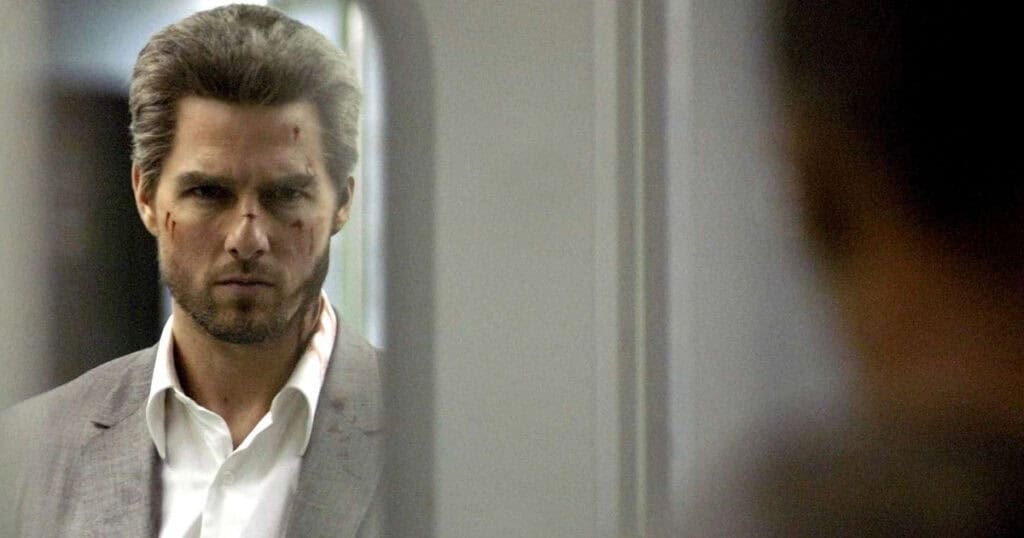
Once Meirelles departed the picture, the project lingered at DreamWorks for three years. Eventually, the script found its way to Russell Crowe, who expressed interest in playing Vincent. Crowe recruited his old buddy Michael Mann to direct Collateral. Once he came aboard, Mann changed the location from New York to Los Angeles. Unfortunately, production delays on the ill-fated Australian movie Eucalyptus resulted in Crowe’s unavailability, and Mann approached Cruise to play Vincent instead. Before Cruise agreed to star in the movie, Edward Norton was offered to play both roles but turned them down. At the time, Mann also cast Adam Sandler to play Max, the taxi driver. Sandler agreed but had to bow out due to his commitments to Jim Brooks’ Spanglish. Once Sandler left, Jamie Foxx was cast as Max after working with Mann on Ali a few years earlier. Although Beattie insisted on DreamWorks casting Robert DeNiro as Max to play the opposite of Travis Bickle in Taxi Driver, the studio opted for a younger actor.
Meanwhile, Leonardo Dicaprio was considered to play Vincent but was too busy making The Aviator with Scorsese. John Travolta was also in the running to play Vincent, while Colin Farrell was offered the part. Farrell passed but worked with Mann on Miami Vice two years later. Johnny Depp was eyed to play Max, and would later work with Mann on Public Enemies. Cuba Gooding Jr. was also in the running to play Max but was turned down by Mann because he had already worked with Cruise on Jerry Maguire.
As for the role of LAPD detective Ray Fanning, Val Kilmer was originally cast but had to leave the project due to his commitments to Oliver Stone’s Alexander. Once Kilmer departed, Mark Ruffalo was cast instead. Meanwhile, the late Dennis Farina was originally slated to play FBI agent Frank Pedrosa but also had to bow out due to his Law & Order schedule. Bruce McGill, another longtime Mann collaborator, was cast in Farina’s place. As for Jason Statham’s silent airport cameo, many have suggested that his character represents Frank Martin from the Transporter franchise.
Once Cruise and Foxx were locked into the leading roles, the two actors immediately hit it off and forged a genuine friendship while making Collateral. Both actors also underwent extensive training to get into their characters. For example, Vincent is a stealth hitman who possesses the ability to blend in without being detected. To prepare for this, Mann ordered Cruise to make undercover FedEx deliveries throughout Los Angeles without being spotted by random civilians.
Cruise was also impressed by the detailed backstories Mann and Beattie had prepared for Vincent and Max and dove headfirst into the character’s history. While much of the information does not make it into the film, Vincent’s love of jazz and upbringing in a foster home with an abusive father helped Cruise hone the character and bring Vincent to life.
For the film’s riveting gun battles, Cruise trained with British military veteran Mick Gould and Special Air Service Seargent Andy McNab. Believe it or not, Collateral was the first movie in which Cruise used live rounds, and extensive safety measures and training were required before cameras rolled. Cruise was so adept at hitting targets during his three-month training at the L.A. County Sheriff’s combat shooting range that Mann famously quipped: “Tom is extraordinarily skilled at everything athletic that he tries.” Indeed, Cruise’s tactical gun draw is so exemplary in the film that it’s been used for instructional training on expert gun handling.
Similarly, Foxx trained as a real taxi driver before principal photography. For the car chase scenes, Foxx prepared by racing old cars at Willow Springs Raceway in California’s Mojave Desert, where Mann would often join him for fun.
Backed by a $65 million budget, principal photography for Collateral began in Los Angeles in October 2003. The film was shot almost entirely on location in remote areas across the city rarely captured on film in a mainstream motion picture. Unlike the glitz and glamor of Hollywood’s affluent neighborhoods, Collateral excels at depicting L.A.’s sordid underbelly and vibrant cultural hubs in areas like North Figueroa and North Union Avenue, Koreatown, South Central’s Liemert Park, Crenshaw Boulevard, and more. According to Mann, extra security precautions were taken on the night of filming the footbridge scene near the hospital due to the area being “hotly contested” by rival gangs. If Collateral feels dangerous, it’s because genuine peril surrounds the production.
To capture a specific visual style, Mann opted to film Collateral using the Viper FilmStream High-Definition Camera, the first mainstream motion picture to adopt the technology. According to Mann, the clarity of certain overhead and long shots of Los Angeles would not be possible without using the HD camera, telling American Cinematographer that Collateral is one of the first films to embrace the unique look of Digitial Video rather than using the tech to mimic 35mm film. Using digital video allowed Mann more freedom and flexibility to film at nighttime with low light. Similarly, Mann stated that without using a Sony F900 HD Digital Camera for the interior taxi scenes featuring Annie (Jada Pinkett Smith), “You wouldn’t see any definition of the images behind them.”
While using the technology for the first time presented its problems, the challenges increased when cinematographer Paul Cameron abruptly departed the production three weeks into principal photography. Cameron left over creative differences, prompting Mann to hire DP Dion Bebee in his place. In addition to the Viper FilmStream HD camera, which Mann toyed with for sequences in Ali and would later use for Miami Vice, the iconic Fever nightclub scene was filmed using 35mm celluloid. According to Mann, roughly 80% of the film was shot digitally, with the remaining 20% shot on film. Although Cameron left after three weeks, he and Bebee won a BAFTA for Best Cinematography for their work on Collateral.
Speaking of Fever, the sequence was filmed in a real nightclub called Club Bliss on Crenshaw Blvd. The exterior of the real club was used, but the interior was constructed on a set to make room for the large amount of background extras.
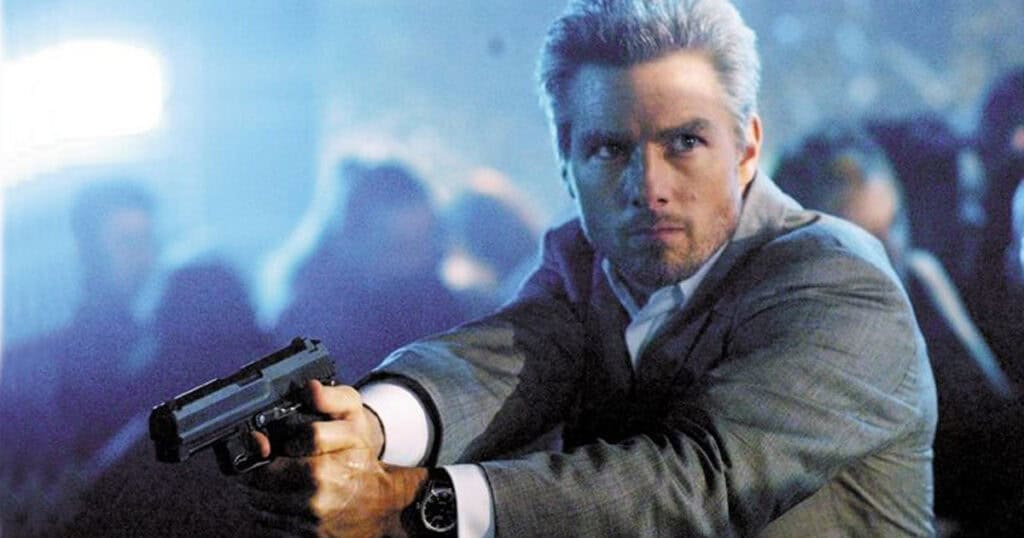
Another crucial scene comes when Vincent forces Max to pose as himself and meet Felix, played by Javier Bardem. Although Bardem spent just two days filming his part, he spent months learning to speak English with a Mexican accent.
As for the scene in which Max’s taxi sideswipes a car with Vincent in the backseat, Jamie Foxx genuinely crashed into the vehicle while filming. Foxx was amused by how everyone rushed to Cruise’s aid following the mishap and paid little attention to his potential injuries. When Max crashes the cab and flips the car several times on the street later in the movie, Mann captures the shot in the first attempted take. Cruise reportedly suffered a concussion and gashed forehead during the crash. Mann felt the result looked too violent and filmed the sequences twice more but opted for the first take instead. A total of 17 taxi cabs were used during the making of Collateral.
Although Foxx accidentally injured Cruise on set, the two actors became extremely close while making the movie. Foxx says Cruise bought the entire cast and crew In-N-Out Burger one night after filming. Once the production wrapped, Cruise showed up at Foxx’s birthday party unannounced and surprised him with a pinata filled with Sour Skittles, his favorite candy. Whether the two remained close after Foxx began dating Cruise’s ex-wife Katie Holmes is anyone’s guess, but the two had a palpable chemistry that continued off-screen after making Collateral.
Meanwhile, one of the most memorable scenes happens at the atmospheric jazz club where Vincent tracks down his third target, Daniel. After Vincent murders Daniel, Max stands up to Vincent and states, “I’m just collateral anyway.” This throwaway line has led many to believe it’s where the movie’s title comes from.
However, the title Collateral refers to Vincent’s professional code name, Vincent Collateral. Beattie’s original script referred to the villainous character as Vincent Collateral and the name is confirmed in a deleted scene that is included in the DVD extras. The title Collateral was considered for a change following the box-office failure of Arnold Schwarzenegger’s Collateral Damage in 2002. While the title was kept in place, Collateral refers to Vincent’s hitman identity, not Max’s victimhood, a cool tidbit fans may not have known about until now.
One of the movie’s most memorable moments comes when Vincent and Max trade fire on a train. Get this, the train sequence was filmed using a CGI green screen background. Mann felt a green screen was necessary due to the precise placement of what is shown through the train windows.
Of course, Michael Mann has earned a reputation as one of the most impeccable filmmakers who takes his time planning precise framing and action set pieces. However, one of Collateral’s most famous moments happened by accident on the spot. In the office showdown during the movie’s intense finale, Vincent throws a chair through a window, steps on it, and falls to the ground on his side before quickly getting up to chase Max. The fall was an unscripted mishap by Cruise at the moment. Mann felt the happy accident was perfect for the character and kept it in the finished film.
Another aspect of the movie that is hard to forget is the soundtrack, which favors alternative needle drops over a traditional musical score. Although nine-time Oscar nominee James Newton Howard was hired to compose the score for Collateral after Hans Zimmer was briefly attached, roughly 17 minutes of Howard’s arrangements were used in the finished film. Howard created more than an hour of original music, but Mann replaced much of his work with music composed by Antonio Pinto.
The remaining source music incorporates pre-existing songs handpicked by Mann. For instance, as soon as Mann heard Audioslave’s “Shadow on the Sun,” he knew he wanted the song to play over the indelible image of a lone coyote wandering down the street. The jazz club scene features a precise cover of Miles Davis’ “Spanish Key” from his iconic Bitch’s Brew album. Even after drifting away from Howard’s original score, Mann curated an eclectic tracklist that adds to the movie’s tonal texture. From Bach and Tom Rothrock to Groove Armada and Calexico, the diverse music remains one of Collateral’s most memorable characteristics. Mann even pulled Vangelis’ score from Ridley Scott’s 1492 and laid it over the scene where the FBI speed to Club Fever.
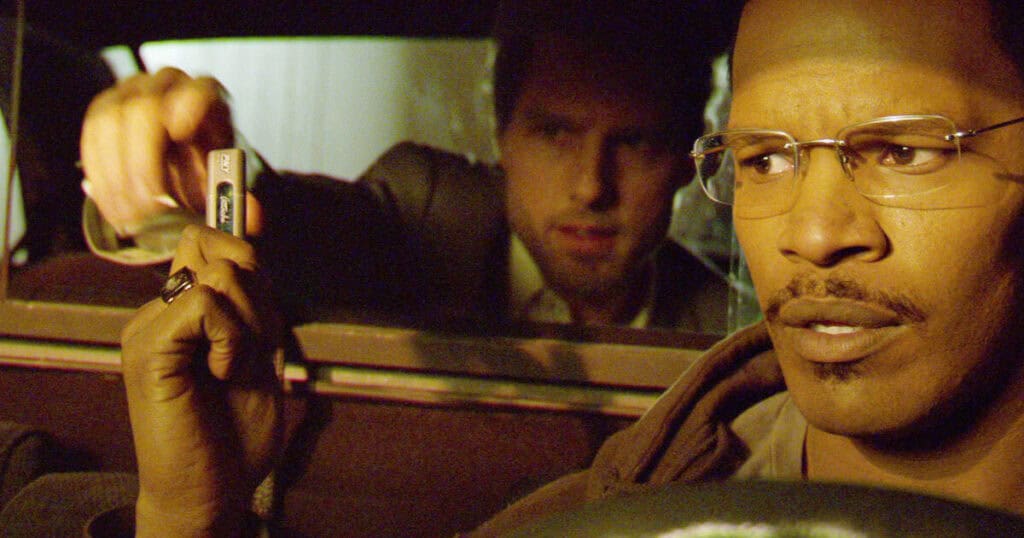
While Mann’s movies tend to be hit or miss at the box office, Collateral became an instant critical and commercial success when it was released in August 2004. Tom Cruise tends to have that kind of draw yet despite playing a villain for just the third time in his career, Collateral grossed over $220 million worldwide against a $65 million budget, scored two Oscar nominations, and currently boasts an 86% Rotten Tomatoes score. Interestingly, many have compared Collateral to Mann’s Hall of Fame L.A. crime movie, Heat.
For instance, notice how Vincent wears a similar grey suit to the one sported by Neil McCauley, played by DeNiro in Heat. Also, the closing shot of the train in Collateral is nearly identical to the opening train shot of Heat. Both movies also feature a key lighting cue that assists the protagonist. In Heat, Vincent Hanna (played by Al Pacino) spots McCauley’s shadow when the airport lights flash at the right time. In Collateral, Max mentions how he got “lucky with the lights” earlier in the film when driving through traffic signals. On the train, Max gets lucky with the lights again when the interior lights go out and blind Vincent long enough for Max to take him out.
There’s also the same line of dialog in both movies. In Collateral, Pedrosa gives instructions to his men as they storm into the Fever nightclub by saying, “Get clean shots, watch your background.” The same line was stated by Lt. Hanna in Heat as he orders his officers to confront McCauley and his crew right before the bank robbery shootout takes place. Whether these touches were meant for Collateral to play as a nocturnal version of Heat is unclear, but the similarities are hard to ignore. Twenty years later, both Mann movies hold up as two of the all-time great L.A. crime movies. If Collateral were released to such success now as it was in 2004, chances are a mandated sequel, prequel, reboot, or needless TV adaptation would likely be shoved down viewers’ throats. It’s nice to know that a standalone classic like Collateral never received such treatment and stands on its own merits in 2024. A few odds and ends aside, that’s pretty much What Happened to Collateral!






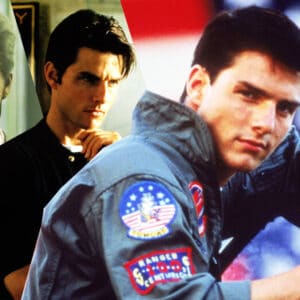
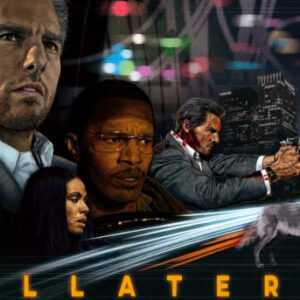











Follow the JOBLO MOVIE NETWORK
Follow us on YOUTUBE
Follow ARROW IN THE HEAD
Follow AITH on YOUTUBE